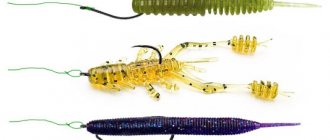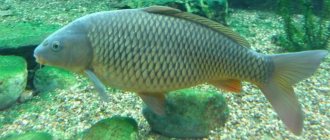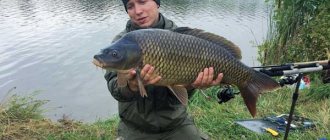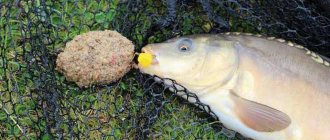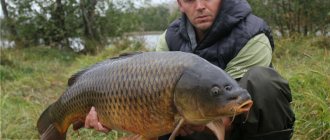Zig Rig A Zig-rig
is a simple way to present a stationary floating bait at any depth you need in the water column, using either a long leader that extends straight from the sinker, or using a
zig rig
that allows you to set the depth. , you need, without tying up all the equipment.
A zig rig is used to catch carp feeding in different layers of water, either simply swimming in a pond or resting on the bottom, in general, located anywhere from a few mm from the bottom to the very surface.
Carp spend a lot more time in mid-water than most people might imagine (or believe). Therefore, the Zig Rig can be super effective every time you go fishing. Zig Rig is especially effective at high atmospheric pressure. Yes, we all know that high blood pressure negatively affects the behavior of carp and we often make allowances for this after unsuccessful fishing trips. It is not true. Carp always eats (except perhaps during earthquakes and other force majeure events). It is worth considering that high pressure often prevails over low pressure. Thus, carp are more often found in the middle and high layers of water than directly above the bottom.
Content
- 1 Types of zig rig equipment 1.1 Zig rig with a fixed length
- 1.2 Adjustable zig rig
- 2.1 Sliding (running) equipment
Types of zig rig equipment
There are two different types of this rig that are used - fixed and variable leader length.
Zig rig with fixed length
Fixed-length zig rig Adjustable zig rig.jpg
As the name suggests, a fixed-length zig rig is a long leash made of fishing line or fluorocarbon adjusted to a certain depth, extending from the sinker to allow catching carp located in the middle layers of water or on a surface. You can change the length of this rig by tying the leash each time.
Leadcore, sinking tube, or leaders of any type cannot be used in the case of a fixed zig rig, due to the possibility of fish disappearing.
A carp pulling a leadcore or tube on a 3-meter leash is just asking for troublesome fishing, clinging to anything on the bottom, so using leadcore or other leaders is neither possible nor necessary.
Pros and cons of fixed length ZIG RIG
- a fixed zig rig gives you the opportunity to use different types of equipment, clips, in-line, etc., to experiment and adapt to specific fishing conditions
- A fixed zig rig with long leads can cause the sinker to literally rip the hook out of the carp's mouth if a weight clip is not used
- a fixed zig rig is very difficult to use in deep water greater than the length of your rod and requires retying or shortening the leader if you want to change the depth at which the rig will be
- a fixed zig rig can be cast over a long distance without the fear of the leader twisting
- In clear shallow water my choice would be a fixed zig rig without a float, which might spook wary carp.
Adjustable zig rig
The adjustable zig rig allows you to measure depth and change leader length using an auxiliary float at the start of the leader and a sliding rig.
After casting, you measure the depth as the line slowly rises until the float appears on the surface. Then you reel the float and bait to the depth you need.
Pros and cons of an adjustable zig rig
- The adjustable zig rig has a phenomenal ability to twist and tangle.
- The adjustable zig rig, due to its design, can only be used with sliding equipment
Types of equipment
Without exaggeration, a zig-rig can be called one of the simplest carp rigs that even an inexperienced angler can tie with his own hands. Thanks to the invention of this simple equipment, the fisherman had the opportunity to present the bait to the fish in any layer of water.
The most common classic installation involves the ability to adjust the depth of the nozzle. This installation includes:
- heavy sliding sinker, the movement of which is limited by a silicone stopper;
- anti-twist, which is a hollow plastic tube 15–20 cm long;
- a voluminous plastic float that can be moved along the leash while fishing;
- connector with which the leash is attached to the equipment.
This installation can be successfully used in cases where the carp does not stand in the same water horizon and during the day can sink closer to the bottom or, conversely, rise to the surface.
On a note! The adjustable design of the zig-rig rig allows you to change the working depth of fishing in a few seconds.
In the fixed zig-rig mounting option, a heavy weight is attached to a stationary clip. In this case, the leash is attached to the clip connector. This type of equipment does not allow you to change the fishing horizon by moving the float along the leash. However, the working fishing horizon can be changed quite quickly if you replace the leash with a longer or shorter one.
In muddy water conditions, the fisherman should use brightly colored foam as bait.
Special attention should be paid to the choice of hook for this equipment. Most carp anglers prefer to use models called “half banana” in combination with a zig-rig, which are distinguished by a curved forearm and a relatively large beard. Such hooks reliably cut through fish even in case of late hooking.
For zig-rig equipment, you can also use hooks with a wide hook. Even small hooks of this shape allow you to fish with a voluminous bait and detect carp well. If an angler uses a rigid leash in a zig-rig rig, then the optimal choice would be a hook with an eye bent outward. The combination of a rigid leader and a hook with a bent eye creates the correct angle of attack when hooking fish.
For this type of installation, hooks No. 8–10 (according to the international classification) are usually used. Number 10 can be used when fishing with floating boilies or small foam balls. Larger models are designed for voluminous artificial polyurethane foam attachments. In any case, the hook must be selected in such a way that the buoyancy of the bait is sufficient to lift it to the upper layers of the water. Since all carp hooks are made of fairly thick wire, which is necessary to hold large fish, the angler has to make a compromise between the weight of the hook and its size.
Installation of carp leashes
Another element that should be given special attention when installing zig-rig equipment is the leash. The working length of the leash when fishing with this equipment can reach several meters, therefore, if you make it from a regular monofilament fishing line, it will constantly get tangled, which will make fishing extremely uncomfortable. Many anglers make leaders from fluorocarbon monofilament, which is completely wrong. Fluorocarbon has a large mass - this negatively affects the buoyancy of the hook with bait and makes the equipment ineffective. Zig-rig leashes are best made from specialized material that has the following characteristics:
- positive buoyancy;
- low “memory”;
- absolute invisibility in water;
- optimal softness.
For fishing with a zig-rig, you should not choose sinkers that are too light, as they will not be able to ensure reliable fixation of the equipment on the bottom soil. In addition, heavy weights provide a great advantage when fishing for carp at long distances, since they can be cast far in any weather conditions.
Interesting! Experienced carp anglers note that in the summer, bites on a zig-rig occur much more often than on other types of rigs.
Types of zig rig equipment
Let's look, first, at a fixed zig rig, since it is possible to install different types of sinker rigs, each with its own disadvantages and advantages, and there is also the possibility of installing a sinker in a clip, which makes fishing for carp simpler and easier. Unfortunately, there is no universal equipment that can be used in all conditions, and different fishing locations require different approaches.
Sliding (running) equipment
ZIG RIG Sliding Rigging The simplest way to rig a fixed ZIG Rig is with a standard sliding rig.
This path gives the best bite registration on the rod, but it also affects the quality of the hook. Since the length of the leader theoretically gives the carp a greater opportunity to move without an indication on the alarm, then most often, with a blind rig, a bite is simply a single “peak” of the alarm or a slight trembling of the rod tip, thus a sliding rig gives the best opportunity to register a bite. A slip rig should always be used when maximum bite sensitivity is required, and if you are fishing in snags or grass, the sinker should be tied to a ring of 3 or 4lb mono line to allow it to come off when hooked.
A running rig can be a good choice, and a clamped reel clutch or a line clamped in a clip can greatly help the hook, because when a carp bites, it feels the hook and understands that this is associated with danger, and there is a risk that it will have time to get rid of the rig with nozzle.
Semi-fixed load
A semi-fixed weight (using a bead, a rubber stopper, in-line equipment, etc.) plays a role in using a zig rig, but only due to the fact that it improves bite indication. The carp must move the load for the alarm to sound. For example, a 4-meter leash with a semi-fixed sinker gives the carp greater freedom of movement without registering a bite with a signaling device. The advantage of this rig option is the impact that occurs when the hooked carp leaves the point, moving the sinker, this slightly helps the hook penetrate deeper.
Sinker in clip
Sinker in a clip Sinker in a clip is the third and final option if you arrived at the fishing spot and received a gift in the form of algae or snags at your point, and this is a good choice for getting rid of the sinker after the bite.
This rig helps you place your bait among thick weeds or snags without the worry of the weight getting tangled and stuck. The clip also has the advantage that when fishing, the carp will get rid of the sinker and come to the surface, without weaving between underwater thickets and snags. To get a guaranteed shot of the sinker after a bite, in order to calmly bring the carp into the landing net, it is advisable not to use this equipment with rubber cones. And at the same time, there must be sufficient bite resistance, that is, the clip must hold the sinker so tightly that a hook occurs, at the same time it must allow the weight to come out of it when fishing. Once the weight is off, landing the carp becomes very, very easy as you no longer have a weight bouncing around and knocking the hook out of the carp's mouth.
Using a weight in a clip leads to the same problems and difficulties as with semi-fixed rigs. Try to make the leash shorter if possible. However, if carp fishing takes place in the weeds, it is better to sacrifice a good bite indication in favor of your peace of mind, knowing that the load will shoot off and the equipment will not get tangled in the weeds.
When using an adjustable zig rig, due to its design, only one rig is possible - running. It is advisable to use ceramic rings in order to minimize resistance and allow easy floating of the bait. When fishing in weeds or snags, the weight can be connected to the ring via low breaking strength monofilament.
Catching carp with a zig-rig is very easy
Zig rig fishing for carp can be incredibly effective during the hot summer months. Fish, as a rule, stick to a thermocline, which means it becomes more difficult to catch them from the bottom during the daytime. This article will be especially useful for those who often prefer to fish on one-day fishing trips. But for those who spend several days on the shore, it is also worth keeping a zig-rig in mind if you want to catch carp in the heat of the day.
Feeding tactics
Dynamic fishing is guaranteed to you. You will have to feed very often, because the zig-rig requires the presence of food in the upper layers of the water. So let’s arm ourselves with a spomb and roll up our sleeves! For those who want to plunge into the professional world of active carp fishing on a zig-rig, welcome to the first hall of our cinema:
If you want something simpler, then read on. For a novice angler who is taking his first steps in this style of fishing, it will be enough to purchase a ready-made mixture for a zig-rig, and also add sweet liquid to it. Click on the two links in the previous sentences - this combination will work for 5+.
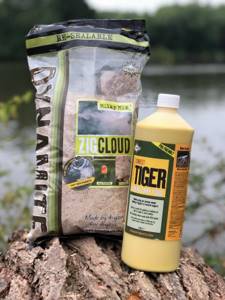
You can see the consistency and amount of water in the video above. You need to get liquid sour cream from your groundbait. In some ways, this is reminiscent of catching bleak; in short, in the water immediately after impact, the bait should form a whole cloud of turbidity.
Feeding tactics: initially cast 12 spombs, and then throw 3 spombs every 15 minutes for... the whole day! Nothing complicated really. Well, unless you have to work hard.
What depth should I start fishing?
The classic starting point is the depth at the fishing point minus 25%. If the depth is 8 meters, then we set a leash of 6 meters, if the depth is 5 meters, then we set a leash of 4.75. And so on. If you have several rods, you can space them out a little at different levels to be able to recognize the depth at which the fish are holding faster.

As an attachment, don’t rack your brains and get yourself a standard set from FOX. It contains foams of the most popular colors, a convenient lazy fastener for foam, as well as a tool for pulling the foam into the fastener. Follow the link, you should pay attention to the product with article number CAC467 .
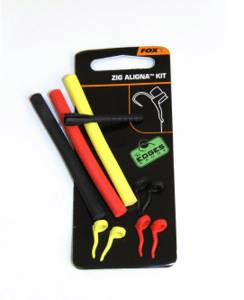
What to use as a nozzle besides foam?
Foam is good, but if your neighbors have gathered around you, then it makes sense to look at the already highly attractive baits. We are talking about pop-ups. But it’s best for you to pay attention either to already very pronounced floating boilies, or to pop-ups, which come with a special booster bottle. Its essence is to further enhance the aroma of boilies after you buy them.
If you are at a loss as to what to choose for the first time, take the yellow fluorine pineapple-banana from Dynamite Baits and feel free to go on a long-awaited fishing trip!
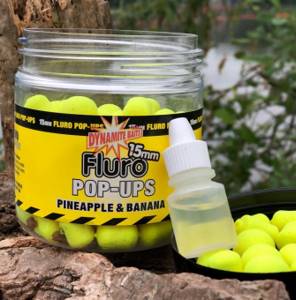
Is it possible to strengthen the bait?
Without a doubt. If funds allow, then add the attractant White Chocolate & Coconut Cream to the above-mentioned mix of zig bait and tiger nut liquid according to the instructions. As soon as you open the bottle, you will hear a simply indescribable sweet, pleasant aroma that will attract even the laziest carp in hot weather.
Advice. Add it right before casting. If you want to achieve increased attractiveness, then pour a little before slamming the spomb. Don't be afraid to overdo it, but don't waste extra liquid either. They sprinkled a little bit into the rocket and threw it away. You can do this every half hour, throwing spomb with the addition of a chocolate attractant.
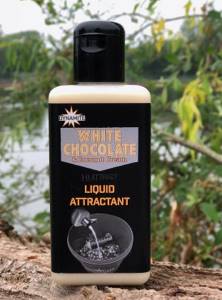
Bottom line
For regular (first) fishing for bait and bait on a zig-rig you will need:
- Set from FOX
- Dynamite Baits pop-ups
- Loose bait for zig-rig
- Liquid Tiger Nut
- As a highlight, chocolate attractant
We look at the technique in the video at the beginning of the article!
Full or partial copying without the consent of the portal editors is prohibited
Lures for zig rig fishing
Lures for Zig Rig Fishing There are many baits you can use for zig rig fishing, you can fish anything that can swim!
Your imagination is only limited by what you have.
There are 2 different groups of baits: natural baits, i.e. baits with nutritional value, and synthetic baits with which you “play” with the carp, arousing its curiosity and desire to taste it. Natural baits are boilies, bread, mixes, insect larvae glued to a foam or cork ball, while synthetic baits include cork, rubber, foam, artificial corn, etc., in general, anything from artificial baits on the market currently. As long as it all floats and can probably stay on the hair for a while, it means it’s all suitable for zig rig!
From observations: boilies on those reservoirs where carp are often caught are sometimes the worst bait, since the carp is familiar with it and it arouses suspicion and apprehension in it instead of curiosity and, as a result, it ignores the bait, and it may seem to you that it is a zig rig does not work. This is wrong. It is much better in reservoirs where there is a large press of fishermen, synthetic baits such as cork or foam, etc. work, since carp by their nature are very curious fish, and they will explore everything new to themselves in a natural way - just take it in mouth. The size of your bait is directly proportional to the size of the fish you'd like to catch, but on high-pressure waters I've found that smaller baits work better.
On reservoirs with less pressure, boilies are an excellent bait for zig rigs, as they actively release flavors and attractants that attract carp, and at the same time they are too tough for small fish. Pop-ups have enough buoyancy to remain on the hair for several days.
To attract carp to my point, and more specifically, to the area where the zig rig is located, I use 2 methods. The first method is to feed the point a mixture of different ingredients, no matter what depth the zig rig is at, in order to interest the carp and make it look for food or at least make it swim at different depths, mixing layers of water, creating cloud of turbidity. The second way is to feed a soup of liquid flavors, various attractants (corn stick liquor, sugar, fish oils, milk, etc.), and small particles. All this is mixed with water from the reservoir, and feeding is done, creating a wonderful cloud of suspended feed particles.
Varieties of Zig Rigs
A zig rig is a simple installation with which you can feed a floating bait at any depth. The classic Zig Rig installation looks like this:
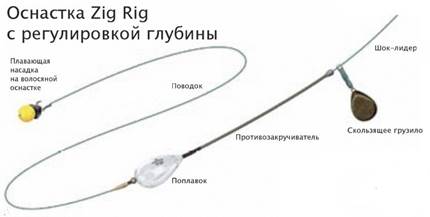
This is a zig rig with an adjustable nozzle depth. As you can see, the main elements of installation are a sliding sinker, which is limited by a stopper. Next comes an anti-twist in the form of a tube. Then there is a float to which a leash with a floating attachment is attached. The leash can be made of fluorocarbon. The essence of this installation is to place the nozzle in the desired horizon. The float moves along the leash, thus changing its length. The leash is attached to the connector. This type of installation is useful in cases where it is not clear at what depth the carp is standing at a given time.
There are zig rigs with a fixed or semi-fixed version. In this case, the weight is unfastened using a clip, and the leash is attached to the connector. The length of the leash remains unchanged. But if necessary, the leash can be easily changed. A fixed zig rig looks like this:
What hooks are best suited for our installation? One of the most proven models are half bananas.
As you can see, such hooks have a curved shank and a fairly large barb. With their help, you can detect carp well even with short hooks.
Another type of hook, which is often used when fishing with zig rig rigs, has a wide mouth.
Since small hooks are required to lift small baits, models with a wide mouth will allow you to effectively hook fish.
Another type of hook that works well for zig rig rigs are models with an outward curved eye. Such hooks are used in conjunction with rigid leashes. They provide the optimal angle of attack.
Mostly hooks Nos. 8-10 are used. Small hooks are used for attaching small pop-ups, foam balls and boilies. When fishing with larger hooks, large balls are used. In general, we need to ensure that the ball lifts the hook into the water column. Since carp hooks are usually made of thick wire, we will reduce the weight of the hook due to its size. Thus, the ball will raise the hook a distance equal to the length of the leash.
Lead material should be selected more carefully. There are materials on sale that are designed specifically for installation of zig rigs. Their peculiarity is that when casting and reeling in, they do not get tangled or twisted, and remain smooth and beautiful after many fishing trips. The leader material is made of transparent monofilament line, a line that is almost invisible in the water. The fishing line is of a floating type, which is very important when using it on a zig rig installation.
As for sinkers, it is better to use models weighing 3-4 ounces. With their help, you can make long casts, and the equipment will be clearly fixed in one place.
On such leashes the bait looks more attractive to carp. It has been noticed that the number of bites on such installations is significantly higher.
Casting zig rig rig
Casting a fixed zig rig is quite simple if you think about it a little. There is no need to twist the leash into rings and protect this structure with PVA, since there is a very high probability that the hook will become tangled when floating and will not untangle properly. Laying the zig rig rig in a straight line on the ground just below the rod tip and making a normal, quiet cast is all that is required in most cases, as the leader and hook move upward when casting and never towards the ground. If there is tall grass or other obstacles on the ground, you can place the rig on some fabric.
The cast should be very smooth, without sudden jerks, which could cause the leash to twist or get tangled in flight. With a smooth cast, you can cast a zig rig at a distance of up to 80 meters without any problems at all, and if necessary, a PVA mesh or foam on a hook with a pop-up will help you cast the rig into the distance, and at the same time be calm that nothing is mixed up .
Compared to a fixed zig rig, casting an adjustable zig rig turns into a nightmare! Very strong braking is caused by the float, which flies behind the sinker, sometimes 8 out of 10 casts get tangled! The easiest way is to make the leader as short as possible and place all the equipment (leader with mounting, float and weight) in a long PVA net. At the same time, it's not a cheap method, and it doesn't look very pretty, but you can be sure that there won't be any confusion, and all the equipment will work great!
An adjustable zig rig may seem difficult to operate, but it is actually easier than measuring depth with a marker float.
After casting, tighten the line until you feel the sinker and then slowly begin to release the line, reeling back 30cm at a time, while counting how many meters you cast until the float appears on the surface, this will give you depth at the fishing spot. You must be patient when doing this as any attempt to quickly release the line will cause the float to rise faster than the bait and there is a possibility of tangling. Although it's a pain in the ass in deep water, caution is essential.
Once the float and bait have floated in, binoculars will help you see that the leader is not tangled and they are separated properly.
If you want to fish from the surface, then all you need to do is tighten the line, sink the float, which will become half-submerged vertically, and place the rod on the stand, turn on the alarm and hang the swinger.
If you want to fish in mid-water, then measure a depth equal to half from the bottom to the surface. (again: binoculars will help you a lot).
Once you have positioned the bait at the required depth, you can check if this is actually the case, since there is a lot of fishing line from the bait to the reel, which introduces its own error. Before this, you have found out the depth at the fishing spot, and it is not difficult to calculate the exact depth at which the bait is located. For example, at a total depth of 3.5 meters, when you want to position the rig at a depth of 2.1 meters from the bottom, all that is necessary is to lower 1.4 meters in 30 cm increments, while supporting and swinging the line so that it straightened up.
A heavy swinger used at close distances can sag to the ground and cause the float to drop a little lower than you would like, so you want a swinger that is as light as possible. As soon as the distance to the fishing point exceeds 15-25 meters, you can safely use a heavy swinger, since the weight of the fishing line compensates for the weight of its swinger, and in this case, everything will work as it should, and you will not worry.
Casting zig rig
This is the question that gets asked again and again. How to cast a Zig Rig without it getting tangled? First of all, the main thing is to keep the equipment very simple.
In addition, before the cast sinker hits the water, you need to slow down the line a little so that the leader and bait come forward and straighten out. If this is not done, the equipment may become tangled. This is especially important when fishing with long leashes. Before casting, I do not place the entire long leader in one place on the ground. I place the bait on the ground (away from the shoreline and where I'm casting) and then walk forward so the leader is straight. This helps prevent tangling and allows you to cast further.
In some places, placing the nozzle on the ground for casting can be problematic: grass, twigs, etc. will interfere with casting. In such cases, I use a small container of water. I put the bait in the water on the surface and cast it. This method is 99% effective in avoiding snags on bushes, reeds, branches and even your tent.

Carp about 16 kg - thanks to the zig rig
Recommendations for fishing with zig rig
- Use waterlogged bulk bait with the addition of a small amount (up to 10%) of pellets, boilies and grains. This will keep the carp in the spot while you are not feeding.
- Use the biggest bombards you can find. This will save you a lot of time trying to get the float to the surface. If the bombard does not have a high lifting force, and even if it is half filled with water, winter will come by the time you raise the float. It is important.
- Use monofilament or fluorocarbon as a shock leader; these materials will be less noticeable in the water.
- It is best to use a combined leash, a hook with a short shank.
- Use a fishing rod that is as rigid as possible; a spod will be optimal for this. This is the case if you need to throw the equipment at 100 meters, if fishing takes place at a distance of up to 60 meters, then any rod will do.
- Invest in good binoculars. It will help you find the rig in windy conditions when it is really difficult.
- Feed as precisely as possible!
- Before feeding, “beat off” the distance along the bombard on the surface and mark a landmark on the opposite bank. After this, you will have to submerge the equipment by half a meter, otherwise, with precise feeding, you will definitely hook the leash with the rocket and pull out the equipment, and the efforts that you spend on feeding and casting will be in vain. It will be a shame.
Feeding when fishing for carp on a zig rig
It is very important to use the right bait when fishing for a zig rig rig. Liquid flavors and oils are added to bait mixtures, which when released into the water form a cloud of turbidity. It is imperative that bait mixtures contain light particles that float quickly.
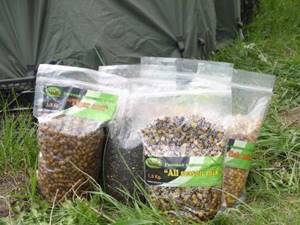
Carp anglers often add bait boilies to their mixtures. The balls quickly dissolve and create a cloud of turbidity. The bait is rolled into balls and thrown to the fishing point using spombs or slingshots. The starter feed consists of 10-15 balls the size of an average apple. The balls can be slightly waterlogged so that they do not disintegrate when touching the surface of the reservoir. This is how carp are fed in areas with a depth of 5 to 8 meters and where there is a slight current. The task is for the balls to reach the bottom and only then should particles and liquid flavors be released from them. It is important that the trail from the bait penetrates several horizons. After the starting feeding, an hour later you can throw a small portion of 5 balls. So-called soups are also added to the bait.
These liquid additives impregnate the mixtures and, when they enter a body of water, produce a fragrant trail.
